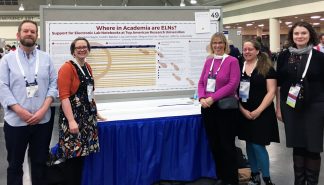by Erinn Aspinall

Electronic Lab Notebook Presentation at ACRL. Left to right: Franklin Sayre, Megan Kocher, Julie Kelly, Meghan Lafferty, Caitlin Bakker. Not pictured: Lisa Johnston.
There’s something romantic about lab notebooks. These bound volumes have held the secrets of the world’s greatest scientific discoveries. Research is changing, however, and with that comes changing needs for documenting the research process.
Today’s lab is defined by big data, collaborative research, and digital information in a variety of formats. These elements combine to create a need for Electronic Lab Notebooks (ELNs), which have become an area of expertise for Franklin Sayre, Pharmacy Librarian.
“ELNs are digital resources that include the elements of their analog predecessors, but also provide enhanced features such as sharing and collaboration, integrated attachments, search capabilities, and even specialized features such as chemical structure drawing and inventory control,” says Sayre.
Collaboration with life science laboratories
Librarians like Sayre have expertise in the organization of information, making them great resources when evaluating the features of ELNs. Sayre has long been interested in ELNs as tools for scientists to record and work with information, and has recently partnered with four life science laboratories who wanted to evaluate how ELNs could support their work.
Through his interviews with the laboratories and through vendor demonstrations, Sayre learned a lot about the important considerations when selecting ELNs.
“I learned that each laboratory has unique needs and a unique culture around how they record data,” says Sayre. “It’s important to think through these needs before you start evaluating particular products. Then you can determine how a particular ELN can support those needs through their specific features — such as their user interface, workflow support, protocols, inventory management, and cost.”
Mike Walters, Ph.D., was one researcher who has collaborated with Sayre. Walters works at the Institute for Therapeutics Discovery and Development in the College of Pharmacy. He found Sayre’s expertise helpful in making an informed and timely decision.
“Frank’s help in setting up the e-notebook evaluations was critical to our selection of the best notebook for our needs,” says Walters. “I expect that it would have taken much longer for us to come to a decision on our own.”
As a result of their consultation, Walters and his colleagues found an ELN solution with features that they love. “We are currently using a cloud-based solution and love that it can be accessed from either Mac or PC platforms.”
ELN support across the Libraries
Sayre’s work coincided with another project at the University of Minnesota Libraries, which was investigating how traditional lab notebooks and ELNs were used more broadly across the University.
Science Librarian Megan Kocher was part of this multidisciplinary team that brought together expertise in the health, physical, and life sciences.
They found distinct approaches to documenting research across disciplines.
“Just as every lab varies in how they make use of lab notebooks, we found a great diversity in how they are used and stored across disciplines,” says Kocher.
Despite these differences, the team found that there are underlying principles that should be considered when selecting an ELN, regardless of the area of research. This understanding of ELN selection criteria has led to the development of guidelines for individuals and groups interested in using ELNs in their laboratories.
Library assistance for ELN decision-making and implementation
While the guidelines serve as a useful tool for ELN comparison, consulting with a librarian can help identify the best ELN for a particular lab.
“Librarians are available to work with researchers and help them think through important questions about functionality, sustainability, and long-term access,” says Sayre. “They can also provide guidance on the various tools offered by different vendors.”
Librarians can also conduct lab visits for a more complete evaluation of needs, which can lead to recommendations on the best ELN solution.
Once a product is selected, librarians can help with the transition to an electronic environment, offering recommendations related to filename conventions, metadata standards, and other considerations that will make data easier to find and understand over the long-term.
Learn more by contacting Sayre at fdsayre@umn.edu or 612-301-1240.




